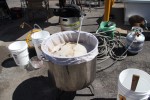For the second article in a row I’m going to respond to a comment on a previous article. I love doing these because I know there is at least one person out there who gives a shit about what I’m about to babble about. Keep suggesting topics, and I’m highly likely to keep writing on them. And thanks to those of you who have done so already.
Anywho, today we are going to delve a little deeper into Rob Dyson’s inquiry about whether warm storage is bad for packaged beers. The short answer I gave him in the comment was “sometimes”. Since that is likely not a very satisfactory answer, let’s explore what can happen to a packaged beer a little more in depth.
First, there are a couple caveats I want to set out before we get going. One is that there is a subsection of packaged beers known as “bottle conditioned” beer. This is beer bottled with the intention of additional microbial activity occurring in the sealed package. There is a lot going on with bottle conditioned beers, and I think we will all be better served by my leaving that for another day than trying to deal with it as part of this topic. Those beers are, at least in part, exempt from this discussion. Second, I want to make sure that everyone understands that a keg is just a large package. If you get draft beer, the keg has just as much potential to have been subjected to mishandling as any bottle does. As we explore potential package issues, you will see that many kegs are less susceptible to some of the problems, but that does not make them immune. A draft keg can be just as fucked up as any bottle if it isn’t handled right. Third, don’t let anyone’s analysis (including mine) deter you from drinking what you like. If you pick up a hot, dusty, clear glass bottle that was sitting in the sun with no cap for a week but really enjoy the beer, don’t let anyone tell you it’s bad. I won’t be trusting your recommendations any time soon, but by all means, keep drinking what you like.
Now to the meat. There are three primary issues that can afflict a packaged beer: oxidation, light, and microbial activity. Oxidation on a chemical level simply refers to the activity of some electronegative substance stripping electrons from another substance. Contrary to what the nomenclature would have you believe, this can be done by lots of things other than oxygen, but for our purposes, oxygen is the primary culprit. Oxygen in solution pre-fermentation is actually quite necessary for yeast activity during fermentation, but after the yeast have ceased their oxygen uptake, remaining or additionally added oxygen can pose a serious threat to shelf life. A wide array of chemicals that should be found in beer can be oxidized into chemicals that may or may not be acceptable. Generally speaking, malty flavor compounds can undergo a small amount of oxidation and actually improve flavor with the addition of honey, sherry, or sweet malt flavors. Oxidation of other compounds (or excessive oxidation of malty compounds) can lead to formation of fusel alcohols, acetaldehyde, or trans-2-nonenal, which tend to taste like alcoholic heat, sour apples, and cardboard, respectively. Diacetyl can even be formed by the oxidation of normal yeast by-products. Heat (even room-temperature heat) tends to hasten some of these oxidative reactions. In short, a little oxygen in a malty beer is ok, but all other beers should avoid it as much as possible, and too much oxygen can spoil any beer. The presence of oxygen in the package is the responsibility of the brewer, but the acceleration of oxidative reactions can be a product of mishandling at any point down the line.
Light is the next potential issue that can damage a packaged beer. Wavelengths of light in the visible as well as ultraviolet spectra can break down a hop compound called isohumulone to produce flavors and aromas reminiscent of the sulphury spray of a skunk. Even beers that are not “hoppy” still have hops and are susceptible to this photochemical phenomenon, though a higher presence of isohumulone can hasten and strengthen the production of these off flavors. The package brewer can combat this issue with light impermeable packaging like kegs or cans or with bottle glass that blocks some of the most damaging wavelengths. Brown glass provides a high level of protection (but not invincibility) while green and blue offer a good deal less, and clear offers none at all. In direct sunlight, this reaction can happen in as little as a minute while ambient sunlight can take a couple of hours, and artificial light can take a couple of days. Pay attention to where your retailer has been storing a bottle before you buy it. Less light is always better.
The final issue to be tackled today is that of microbial activity. This is another world that is rife with complexity, so I’m very likely to gloss over a great deal here and try to treat things in a little more detail later on. There are a variety of microorganisms involved in the production of beer. Some of them, such as yeast, are to be encouraged, while others, such as coliform bacteria, are not. Sours and wild beers can be intentionally exposed to a range of yeasts and bacteria to produce the flavors characteristic of those styles. Any sort of wood or barrel aged beer is highly likely to contact some sort of microbe living in wood, which is difficult to completely sanitize due to its porous nature. Realistically, most beers end up with some degree of contact with some microorganisms that should not be there. If this is minimal, the undesirable by-products of these critters are so far below the flavor threshold that you would never know. Additionally, there are things a brewer can do to minimize this contact and halt any activity after the beer leaves the brewery. Two such options are sterile filtration and pasteurization. The upside of these processes is that they remove microorganisms that could continue to metabolize and produce off-flavors in the bottle, can, or keg. The downside is that they can potentially strip away some flavor themselves. The brewer must play this balancing game.
Armed now with the understanding that almost all beer will contain some level of microbial life and the presumption that few craft brewers take the extreme (and perhaps flavor reducing) steps necessary to completely sterilize the product, we can see that most of the beers you buy in the package will still have some of this life in them. We also know for a fact that these microbes cannot be reasoned with but can be accurately predicted. Given conditions conducive to metabolic activity, they will metabolize, no matter what future reward you promise them or threat you make against their family. Here is where the storage temperature plays a big role. Most of the common off-flavor producing microbes like to eat, play, and excrete in a temperature range remarkably similar to those humans like (or a little warmer). A much colder temperature, however, can be anathema to these little guys. The cold often won’t kill them, but should curtail any grossness production they may be inclined to engage in. Even cellar temperatures can slow or halt microbial activity but are less safe than true refrigeration. Therefore, any time spent cold should mean that no new activity is occurring while any time spent warm (or hot) means that microbes could very well be going to work creating a buffet of unpleasantries. My advice? Buy your beer cold, try to get beer that has always stayed cold, and keep it cold after you buy it. To do otherwise is to court potential destruction. Until then, faithful readers, thanks for reading, and happy drinks!
P.S. Remember to let me know if you have some specific topic you would like me to babble about next time. You can tell me in person, by e-mail, or in the comments right down below.





